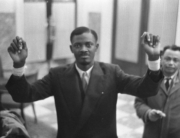
In the startling opening of Ukrainian director Sergei Loznitsa’s State Funeral, the vivid colors of old newsreel footage come as a shock. The bright Soviet red of the fabric-covered coffin catches the viewer’s eye as it’s pulled out of a teal-colored van and borne on the shoulders of gray- and brown-uniformed military men into a drab green building. The next scene switches to lustrous black and white as the coffin is placed on a bier and the lid is taken off to reveal the embalmed body of Joseph Stalin, the feared leader of the Soviet Union who died of a stroke at age 74 on March 5, 1953. A final color shot before the title credits rolls depicts the late dictator lying in state in Moscow’s Pillar Hall of the House of the Unions, surrounded by a veritable jungle of funeral wreaths, flowers, and potted palms and plants.
Loznitsa’s (My Joy) latest archival documentary draws on 40 hours of material found in the Russian State archive in Krasnogorsk—shot by 200 cameramen, beautifully restored by the filmmaker and his team, and skillfully edited by Danielus Kokanauskis into 135 minutes—to chronicle the four days of state-sanctioned mourning that swept the Soviet Union and its satellite states. From the announcement of Stalin’s death to villagers in Tajikistan and oil rig workers in Azerbaijan to the arrival of foreign dignitaries, the endless parade of ordinary citizens streaming past the open casket, and the epic funeral in Red Square, the director seeks to immerse viewers fully in the personality cult—abetted by an efficient propaganda machine—that marked Stalin’s 30-year reign.
There is no narration or subtitles to distract the audience. The only captions identify a particular location. Instead, a cinematic montage of striking images captures the remarkable spectacle. Housewives and children anxiously deposit elaborate floral wreaths and potted plants at the pedestals of monuments to Stalin across the Soviet empire as if they were making offerings to an angry god. The mass of people lined up to get into the House of the Unions turns into an undulating wave that threatens to overwhelm viewers. (It’s estimated that 109 Russians were trampled to death, and the number may be higher.)
The faces of everyday Soviets as they pass Stalin’s corpse range from weepy to stony, although in a brief amusing moment, a bald man peers through opera glasses for a closer look. Artists take a cast for a death mask or make sketches for a posthumous portrait, and Stalin’s bizarre bubble-topped casket (so his face could be seen) is paraded on a horse-drawn gun carriage to Red Square, where it is entombed (until 1961) in Lenin’s Mausoleum.
Perhaps the most striking visual comes at the conclusion; a portrait of the late leader is conveyed by crane to a factory site, accompanied by the ringing of church bells. Stalin has become an icon, an image that recalls Fellini’s famous sequence in La Dolce Vita of a helicopter transporting a statue of Christ over Rome. Vladimir Golovnitski’s atmospheric sound design adds to the visual impact (the lugubrious tones of disembodied announcers, the shrill sound of factory whistles, the tramping of boots, the weeping of women).
Unfortunately for viewers unfamiliar with Soviet history, the lack of context via explanatory voice-overs, identifying captions, and subtitles translating speeches make for a viewing experience that is hypnotic yet exhausting and dull in its repetitiveness. Was that young couple near Stalin’s casket his children, Vasily and Svetlana? Is that Nikita Khrushchev standing guard? Who are the middle-aged politburo members giving boring speeches at his funeral? The filmmaker does include a kicker of a closing text that totals Stalin’s body count: 27 million murdered, 15 million starved to death.
Fans of Armando Iannucci’s 2017 black comedy The Death of Stalin, which depicted the power struggle that followed the Soviet leader’s demise, may be curious to see the banal reality. Likewise, students of Soviet history and propaganda documentaries may also find this well-done and chilling study in the cult of personality compelling.






Leave A Comment